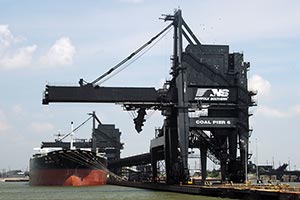Coal's Hard Slide Felt at Port in Hampton Roads

Coal exports from the port in Hampton Roads continued to tank in the first six months of 2016, following a portwide, year-over-year drop of about 35% in 2015.
Hampton Roads is the biggest coal-exporting port in North America. Business, however, for the first half of the year still sank, down nearly 30% from the same period in 2015.
The port’s three big coal terminals – Norfolk Southern Corp.’s Pier 6 terminal at Lamberts Point and Kinder Morgan’s Pier IX and Dominion Terminal Associates in Newport News – exported 10.87 million tons for the first half of 2016, down from 15.46 million in the same period in 2015, according to T. Parker Host, a Norfolk-based ship agency.
Pier IX saw the largest year-over-year drop in exports so far in 2016 – nearly 48%. Dominion Terminal Associates, or DTA, was off by about 28% and Norfolk Southern’s Pier 6 by roughly 20%.
Coal production in the United States is expected to drop by 155 million tons in 2016, a decrease of about 17%, the largest decline in terms of both tons and percentage since data collection began in 1949, according to the Washington, D.C.-based U.S. Energy Information Administration.
A slight rebound in production — 27 million tons or a gain of 4% — is projected for next year.
Coal burned by utilities to generate electricity accounts for more than 90% of U.S. coal consumption. A projected 10% decline in consumption this year is tied to competition with natural gas, which has been cheaper, and “warmer-than-normal winter weather” in the first quarter of 2016 that led to a drop in electricity generation, according to the EIA.
Only a fraction of the coal produced in the United States is exported — slightly less than 10% is projected for the three-year period from 2015 through 2017, said Elias Johnson, an EIA energy analyst.
“The United States is a swing supplier in the world market,” he said, adding that its prime overseas markets have been in the Atlantic Basin, Europe and, to some extent, South America, particularly Brazil.
For a brief period, from about 2008 through 2012, U.S. coal exports surged as demand from China boomed, along with that of Brazil and India, Johnson said.
Since then, things have cooled off. U.S. coal exports fell for the third year in a row in 2015, according to the EIA.
“Slower growth in world coal demand, lower international coal prices and higher coal output in other coal-exporting countries contributed to the decline in U.S. coal exports,” the EIA reported earlier this year.
“Lower mining costs, cheaper transportation costs and favorable exchange rates [compared with the U.S. dollar] continue to provide an advantage to producers in other major coal-exporting countries such as Australia, Indonesia, Colombia, Russia and South Africa.”
The world market is split between “metallurgical” or “met” coal, used in steelmaking, and steam or “thermal” coal, which is used in electrical power plants.
Only about 2% of the coal moving through Hampton Roads is barged to utility plants on the East Coast. The rest is exported, and much of it is high-quality metallurgical coal from Central Appalachia, where production has been scaled back because of high costs relative to the current global supply, leading to the closing of some mines.
Last month, two of the port’s three coal terminals saw an uptick in exports — especially at Pier IX, which saw a nearly 163% increase from May.
In a newsletter, coal-industry expert Jim Thompson wrote that the spike at Pier IX may be linked to an increased demand for metallurgical coal:
“While time will tell, indications are that the improvement on the met side could have legs. We will see.”
David Host, chairman and CEO of T. Parker Host, said last week that if Hampton Roads maintains the business it had in the first half of the year, it’ll export 21.7 million tons in 2016, down from 26.7 million tons last year.
“The export numbers are going to be lower, historically, but we’ve seen them a lot lower,” he said, adding that in 2002, the port exported less than half of last year’s total — 12.5 million tons.
“In theory, there’s always going to be a demand for metallurgical coal,” Host said. “The question is how much of a demand.”
Bottom line: “Coal is not going to go away.”

